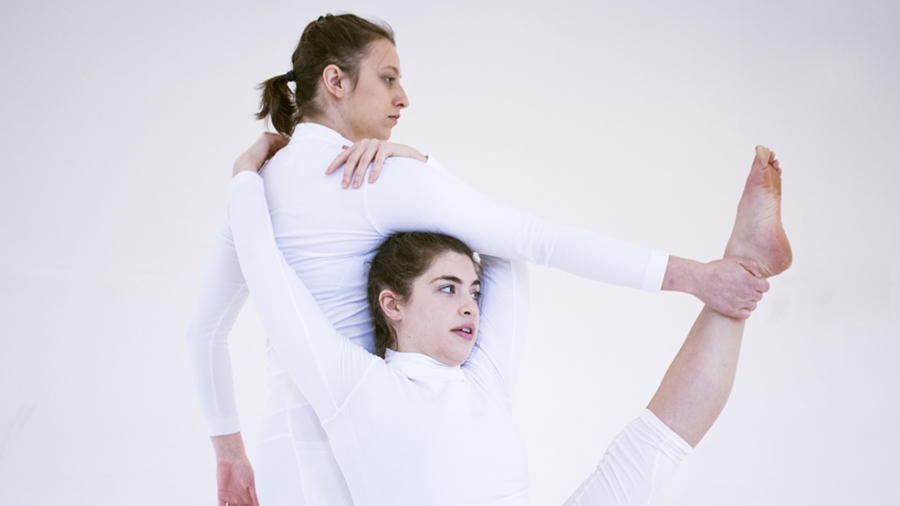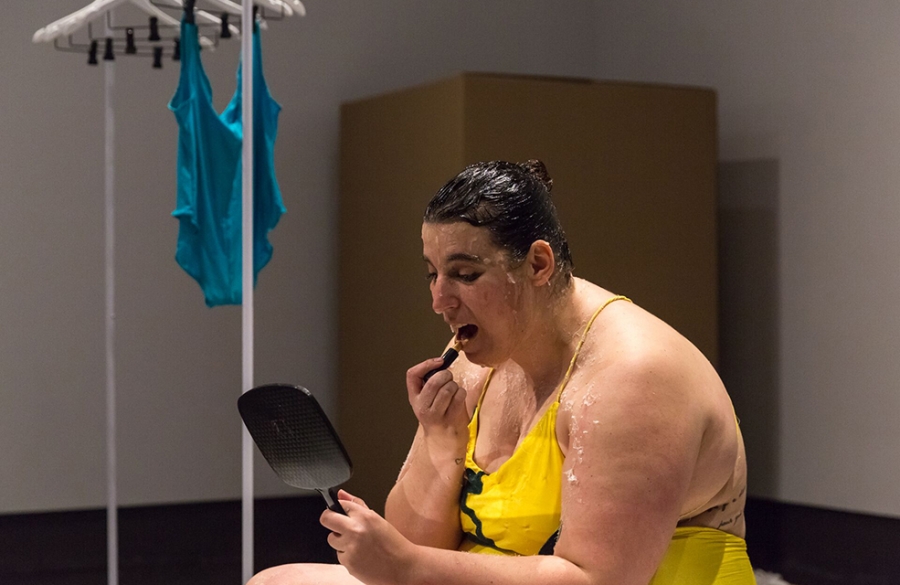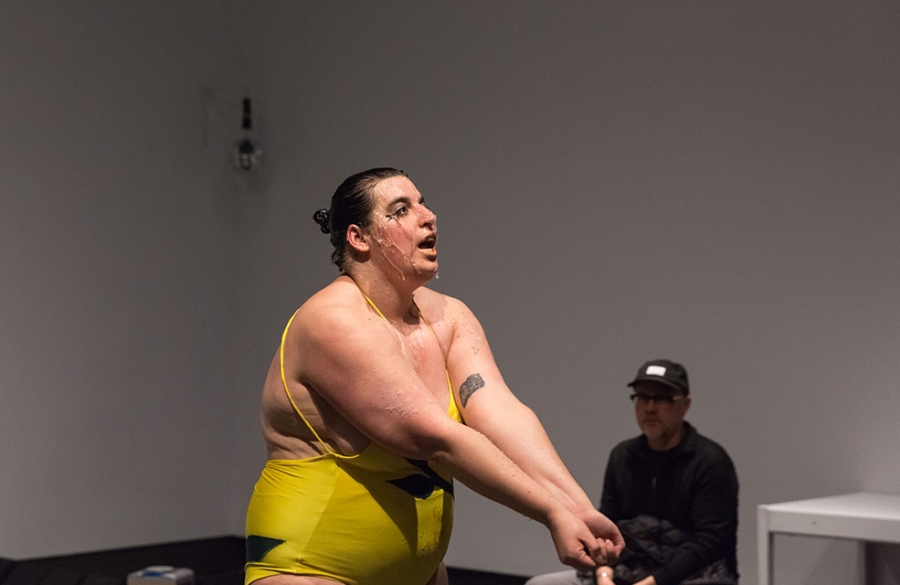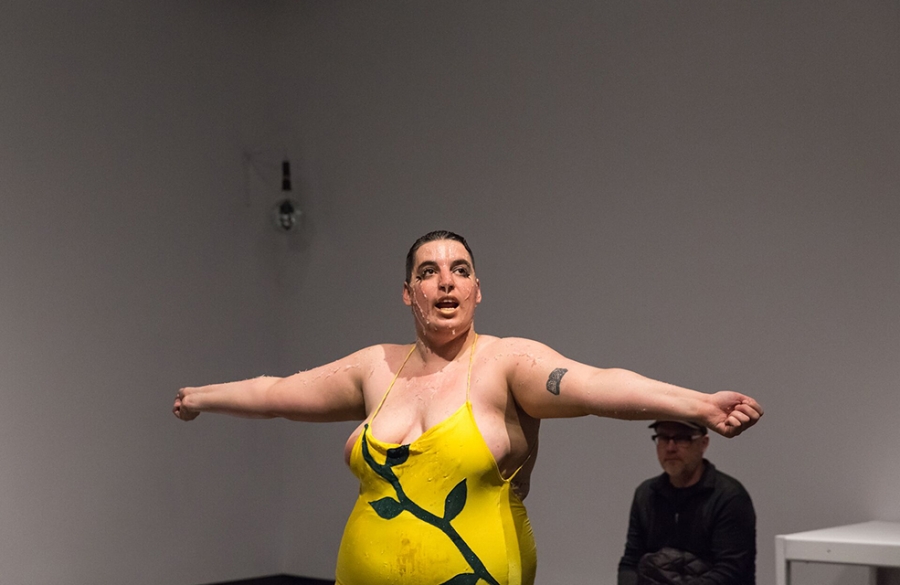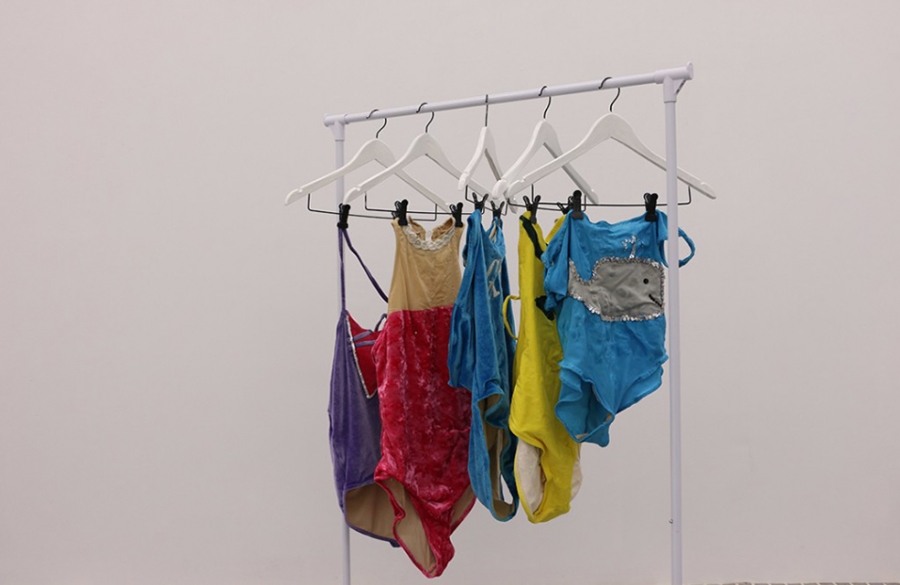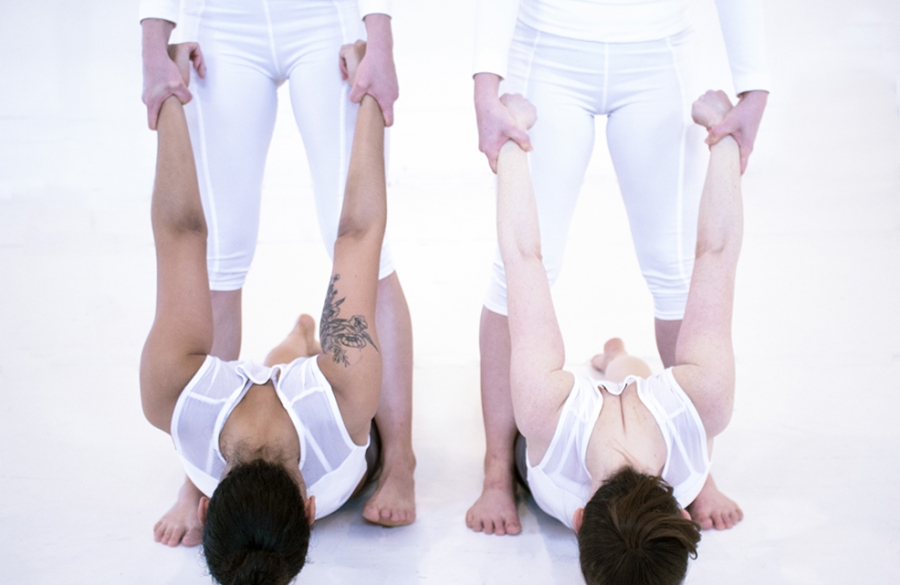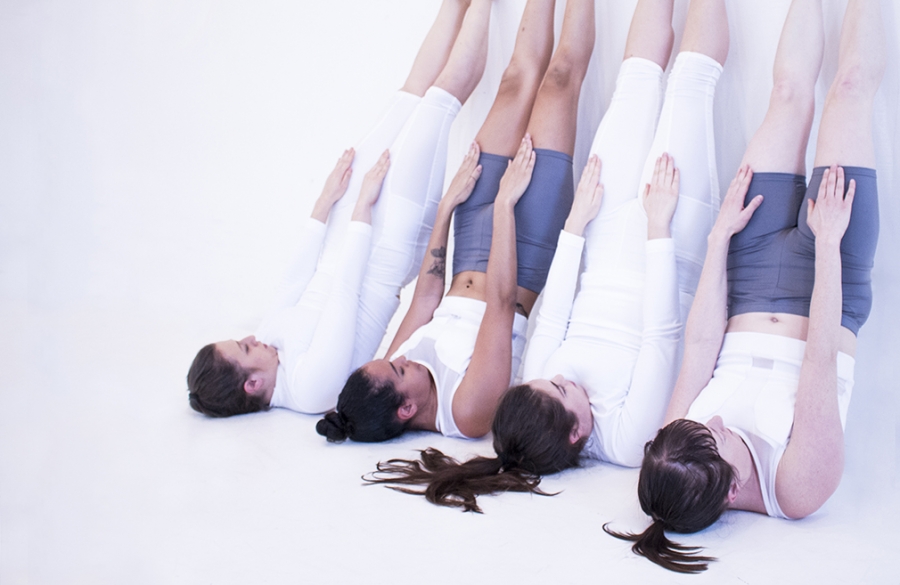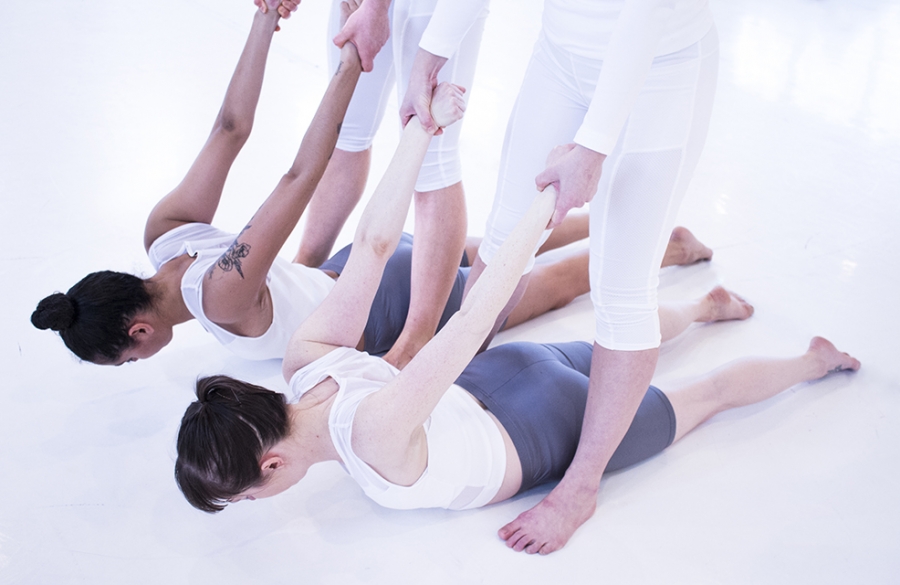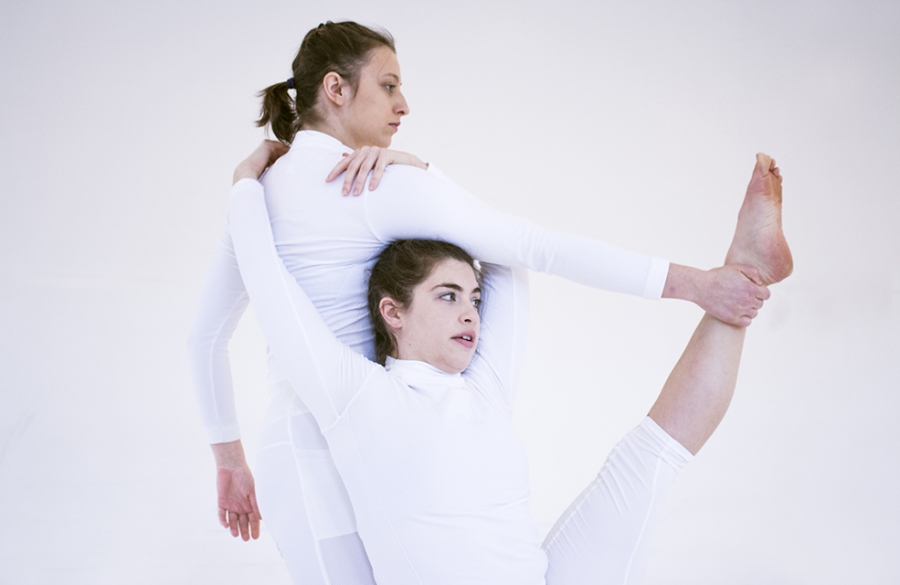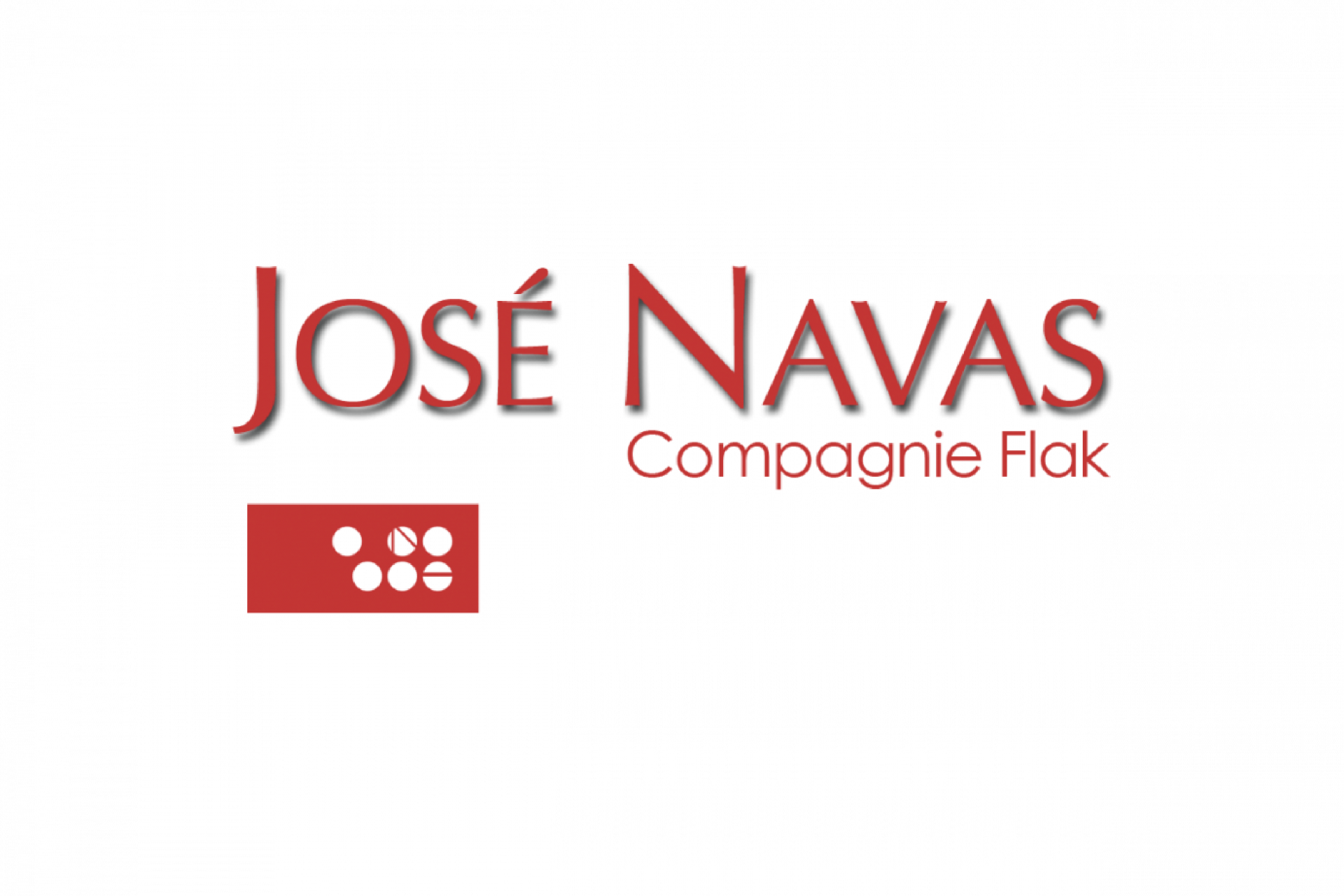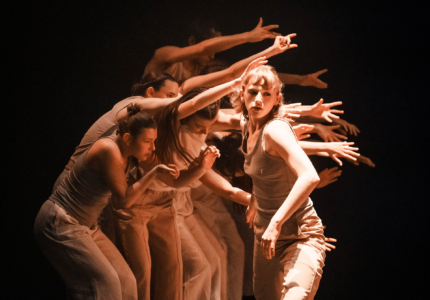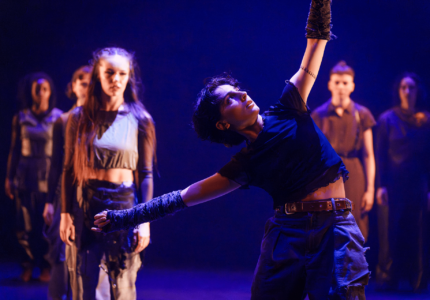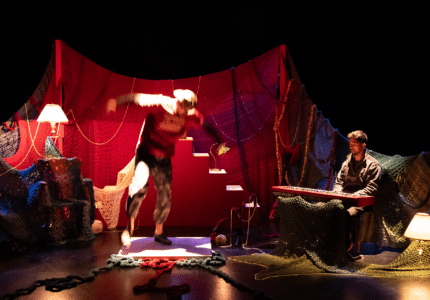Double bill
Liliane Moussa & Caroline St-Laurent + Tess Martens
NOVEMBER 21. 22. 23, 2019 - 7:30PM
NOVEMBER 24, 2019 - 4PM
-
DISCUSSION WITH THE ARTISTS ON NOV. 22
Tess Martens (Toronto)
Slow Change
Tess’s performance art serves as a self-portrait from childhood through adulthood and is particularly focused on periods marked by mental health issues and illness. In Slow Change, she uses a slapstick strategy as she attempts to put on synchronized swimming costumes from her youth and re-enact her former routines. This work proposes an authentic moment, a state of vulnerability from which emerges the power of being a woman and an artist.
Performance Tess Martens
Lighting designers Chantal Labonté and Claire Seyller
Tess Martens completes her Master of Fine Art at the University of Waterloo in 2018. Her thesis is on personal narrative through performance art. Martens facilitates an artist-run gallery, The Front Room Gallery, in Waterloo, Ontario, and features visual artists monthly as well as bands, disk jockeys, and poets. She is also part of the programming committee for CAFKA (Contemporary Art Forum of Kitchener & Area) and has a voice in selecting public art artists. Martens interviews artists for the arts and culture blog culturefancier.com. She is a recreation therapist and in her free time performs stand-up comedy, spoken word, poetry, and karaoke. She was shortlisted for the 2018 Community Edition #Bestof Waterloo for Performance Artists.
Originally from Windsor, Ontario, Chantal Labonté is a graduate of the University of Ottawa Theatre Department and the National Theatre School of Canada Production program. She specializes in lighting design for both French and English theatre. Since graduating, she has had the chance to work with Adrienne Wong, Isabelle Leblanc, Joel Beddows, Pier Rodier, Christian Lapointe, Vera Leticia, Jean-Stephane Roy, as well as emerging directors like Frederic Sasseville-Painchaud, Clara Prévost, Rebecca Vachon, and Eric Perron. She is also the recipient of two Best Design Curtain Awards of the Year in the Ottawa-Gatineau region for We will see by Théâtre du Trillium in 2016 and Les Passants, a co-production between the GCTC and the Catapult in 2017. Chantal tours internationally with Compagnie Marie Chouinard and assists lighting designer Nicolas Ricard in several productions, events, and festivals.
Liliane Moussa & Caroline St-Laurent
Nadia, est-ce que ça va?
Four performers make a foray into the world of competitive gymnastics and plunge into a ritual, a display of strength, an insatiable quest for flawless movement. In the era of denunciations of abuse, this ode to sports questions our collective blindness to power relations in performance contexts. This choreographic work plays with the emblematic figure of the perfect athlete and illustrates the dichotomy between the fragility and resilience of trained bodies. Nadia, est-ce que ça va? asserts the power of women and calls for a team spirit that fosters benevolence.
Choreography Liliane Moussa
Costume design and installation Caroline St-Laurent, in collaboration with Taos-Daphné Houasnia
Performance Marilyn Daoust, Anne-Flore de Rochambeau, Marine Rixhon, Liane Thériault
Sound design Anna Atkinson
Rehearsal direction Sarah Williams
Lighting designers Chantal Labonté and Claire Seyller
Liliane Moussa is a dance artist based in Montréal. She graduated in 2012 from UQAM and then created her artistic path in the hybridization of dance and sports. She’s interested in the artistic content of the total physical commitment in sports movement as well as in the concepts of effort and performance attached to it. Her choreographic work was presented in Montréal, Vancouver, and Chili, as well as in in non-traditional sports venues (i.e. Shakti Rock Gym). Liliane is the co-founder and co-director of the dance collective Alt-Shift with Anne-Flore de Rochambeau. The collaborative and in situ project Entrelacs toured in Québec, British Colombia, and France. She also has a physiotherapy practice since 2006. As an artist as well as a physiotherapist, Liliane ponders more efficient ways of moving, structuring gesture and progressing, both individually and collectively.
In a multidisciplinary practice, Caroline St-Laurent combines art and sports to engage in a feminist critical analysis of the cult of performance. She completed a Master’s degree at the Université du Québec à Montréal in 2012. Recently, she and women athletes/artists have experienced her devices at Art Souterrain (Vélo à écrire, 2017), OFFTA (Relais papillon, 2016), Tangente (Relais papillon, 2015), as well as at a basketball court in Montréal (Visez l’excellence en vous!, 2015). Her work has been presented in solo and collective exhibitions as well as in video festivals in Canada, Europe, and Asia.
Liane Thériault is a dance performer, choreographer, rehearsal director, and video artist. As a performer, she has danced for Les Soeurs Schmutt, Anne-Flore de Rochambeau, Julie Lebel, Delphine Véronneau (Tuque et capuche [TeC]), Liliane Moussa, and Claudia Chan Tak, among others. Since 2015, her choreographic work has been presented in Montréal; first, as a solo, (Personne(une), Somebody), then within a creative duet (Mine de rien: un collectif). Since 2013, she is part of Dans son salon; first as a video artist and then as a rehearsal director. As a video artist, she has also worked with La 2e porte à gauche, Helen Simard, and Karenne Gravel.
Following her academic training in Paris, New York, and Montréal (UQAM, 2012), Anne-Flore de Rochambeau is developing her practice as a performer and choreographer since 2013. Her work is presented in and around Montréal, as well as in Toronto and France. In parallel, she has co-created Alt-shift with the choreographer Liliane Moussa. This collective aims to develop in situ and immersive choreographic projects, including Entrelacs, which has touring in Québec, France, and British Columbia. In Montréal, she has recently performed with Parts Labour_Danse, Les Soeurs Schmutt, and Martin Messier. Since 2018, she also performs in France with the company Christian & François Ben Aïm in their new series Instantané.
A graduate from UQAM in dance (2011), Marilyn Daoust has received two CCA scholarships to hone her skills in Catalonia and Austria, and has also trained in Chile and Belgium. Both here and abroad, she dances for Manon Oligny, Louise Bédard, Daina Ashbee, Martin Messier, Lucie Grégoire, Les Soeurs Schmutt, Liliane Moussa, and Delphine Véronneau. Marilyn also served as spokesperson for the 2017 Accès Dance Festival. In the field of theatre, she collaborates with Florent Siaud, Benoit Vermeulen, and Nini Bélanger as a movement assistant. She choreographed and performed Angela Konrad’s play Last night I dreamt that somebody loved me (Usine C, 2017). Marilyn Daoust co-founded For Fauve with Laurie‑Anne Langis.
Originally from Belgium, Marine Rixhon has been living in Montréal since 2009. After pursuing academic studies in classical and contemporary dance in Liège, Toulouse, and Montréal, she works with choreographers Les Soeurs Schmutt, Anne-Flore de Rochambeau, Liliane Moussa, Martin Messier, and David Albert-Toth and Emily Gualtieri (Parts+Labour_Danse), from whom she commissioned the duet By The Skin of Your Teeth with Anne-Flore. In 2017, she joins the company Van Grimde Corps Secret. Invested in the dance community, Marine is also a founding member of [LE]CAP, a reflective collective gathering contemporary dance artists and an active member of Alt-Shift dance collective.
Anna Atkinson is a singer-songwriter, composer and multi-instrumentalist who lives in Montreal. Trained as a classical violist, she creates music that combines elements of art song, minimalism and electro-pop. She has released two albums: Mooniture (2011) and Sky Stacked Full (2016). Anna has contributed, both as creator and performer, to dozens of projects in music, theatre, film and dance. She is currently collaborating on a new project with theatre company Joe, Jack et John and is about to release the debut album for her songwriting project, Linaire.
Sarah Williams has been working in the Canadian and Québec dance scenes for over 30 years. She has danced with prominent choreographers and companies, including Holy Body Tattoo, Louise Bédard, Benoît Lachambre, George Stamos, and La La La Human Steps. She has been an artistic advisor, a rehearsal director, and a choreographer for dance, opera, performance art, video and theatre, and has co-created projects with artists Emilie Monnet, Nikki Forrest, Marie Brassard, and long-time collaborator Jackie Gallant. Currently, Sarah is the rehearsal director for Animals of Distinction’s Frontera, a performer in Helen Simard’s Requiem Pop, and is planning a new evening of commissioned works.
Originally from Windsor, Ontario, Chantal Labonté is a graduate of the University of Ottawa Theatre Department and the National Theatre School of Canada Production program. She specializes in lighting design for both French and English theatre. Since graduating, she has had the chance to work with Adrienne Wong, Isabelle Leblanc, Joel Beddows, Pier Rodier, Christian Lapointe, Vera Leticia, Jean-Stephane Roy, as well as emerging directors like Frederic Sasseville-Painchaud, Clara Prévost, Rebecca Vachon, and Eric Perron. She is also the recipient of two Best Design Curtain Awards of the Year in the Ottawa-Gatineau region for We will see by Théâtre du Trillium in 2016 and Les Passants, a co-production between the GCTC and the Catapult in 2017. Chantal tours internationally with Compagnie Marie Chouinard and assists lighting designer Nicolas Ricard in several productions, events, and festivals.
Nadia, are you okay? is an examination of the adrenergic experience of performance, of the feeling of belonging, of the quest for perfection and the setbacks of success in competitive environments. It echoes the news in recent months, which brought to light situations of abuse of power in sports and artistic environments; news that instinctively demanded a need to resume a choreographic work begun in 2015. The piece revisits the choreographer’s memories as a gymnast and draws on the personal experience of the four women onstage to explore the gray areas of the idealistic image of the sports or artistic spectacle. Liliane comes together with visual artist Caroline St-Laurent to suggest an aesthetic that illustrates the dichotomy between the fragility and the resistance of trained bodies.

